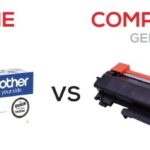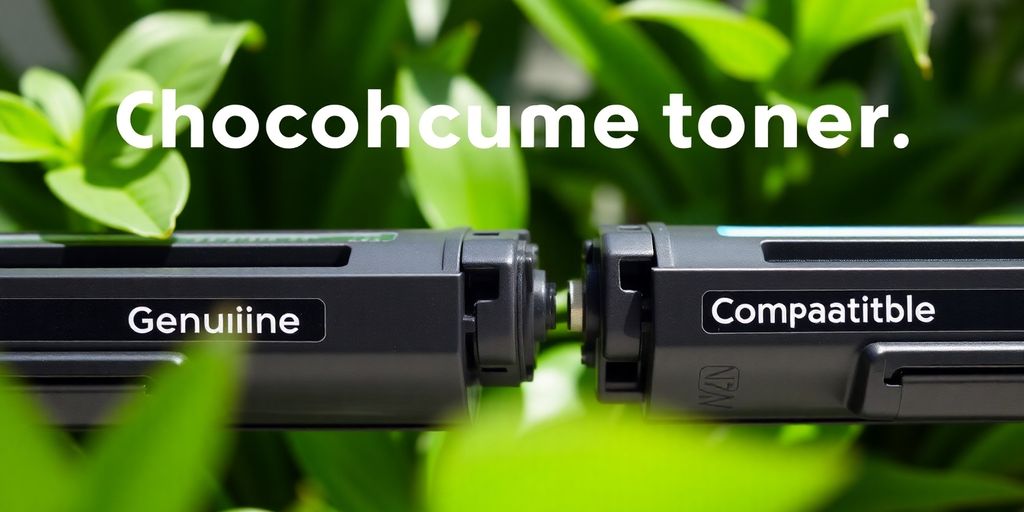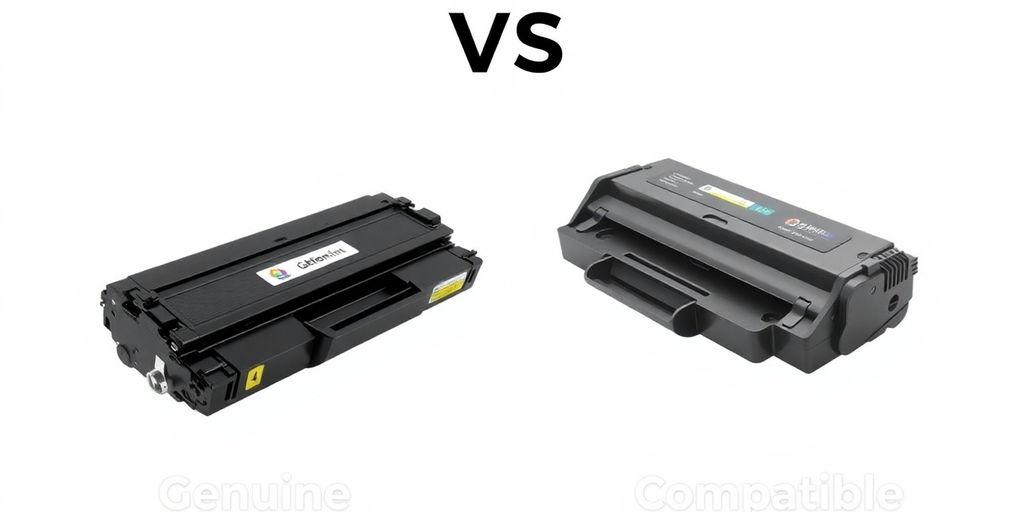Genuine vs Compatible Toner Cartridge
Contents
- 1
- 2 Genuine vs Compatible Toner
- 3 Understanding Genuine vs Compatible Toner
- 4 Print Quality: Genuine vs Compatible Toner
- 5 Cost Considerations for Genuine and Compatible Toners
- 6 Page Yield and Efficiency
- 7 Risks and Reliability
- 8 Environmental Impact of Toner Choices
- 9 Making the Right Choice for Your Needs
- 10 Conclusion
- 11 Frequently Asked Questions
- 11.1 What is the difference between genuine and compatible toner?
- 11.2 Does using compatible toner affect print quality?
- 11.3 Is it cheaper to use compatible toner?
- 11.4 Can using compatible toner harm my printer?
- 11.5 How does toner choice impact the environment?
- 11.6 What should I consider when choosing toner?

Genuine vs Compatible Toner
Genuine vs Compatible Toner Hey there, ever wondered about the difference between genuine and compatible toner cartridges? It’s a bit like choosing between name-brand and generic products at the store. Genuine toners come from the same folks who made your printer, while compatible ones are third-party alternatives. Both have their pros and cons, and picking the right one depends on what you need most—quality, cost, or maybe just peace of mind. Let’s dive into the details and see what works best for you.
Key Takeaways
- Compatible toners are third-party products, often cheaper but may vary in quality and reliability.
- Print quality is generally better with genuine toners, offering consistent and vibrant results.
- While genuine toners are pricier upfront, they often prove more cost-effective over time due to higher page yields and fewer issues.
- Consider your printing needs carefully—if you print a lot, genuine might be worth the investment; for occasional use, compatibles could save you some cash.
Understanding Genuine vs Compatible Toner
Definition of Genuine Toner
They offer consistency in print quality and are less likely to cause damage to your printer.
Definition of Compatible Toner
While they can be a more affordable alternative, the quality can vary widely. Some compatible toners might closely mimic the original, but others might not meet the same standards, leading to potential print quality issues or even printer damage.
Key Differences Between Genuine and Compatible Toner
- Price: Genuine toners are generally more expensive than their compatible counterparts. However, compatible toners offer a cost-effective alternative for those on a budget.
- Quality: Genuine toners typically provide superior text and image quality, with more accurate colors and sharper images.
- Reliability: Using genuine toner reduces the risk of malfunctions, whereas compatible toners might lead to inconsistent print quality or printer damage.
Choosing between OEM toners and compatible cartridges involves weighing the cost savings against the potential risks. While genuine toners offer peace of mind with their reliability and quality, compatible toners can be a budget-friendly option if chosen carefully.
Print Quality: Genuine vs Compatible Toner
Impact on Text and Image Quality
They produce sharp, crisp text and vibrant images, which is crucial if you’re printing professional documents or high-quality photos. On the other hand, compatible toners might not always deliver the same level of precision. The quality can vary significantly depending on the manufacturer, leading to text that might appear slightly faded or images that lack the punch of genuine cartridges.
Color Accuracy and Consistency
Color accuracy is another area where genuine toners excel. They are engineered to produce colors that are true to life and consistent across multiple prints. This consistency is vital for businesses that rely on precise color matching, like design firms or marketing agencies. Compatible toners, while cheaper, can sometimes struggle in this department. You might notice color shifts or variations from one print to the next, which can be frustrating if you’re aiming for uniformity.
Longevity of Prints
Print longevity is a key consideration, especially if you’re archiving documents or creating materials meant to last. Genuine toners tend to produce prints that resist fading over time, maintaining their integrity for years. In contrast, prints from compatible toners often fade more quickly, which can be a deal-breaker for long-term projects. If longevity is a priority, investing in genuine toner might be worth the higher upfront cost.
Choosing between genuine and compatible toner isn’t just about price—it’s about what you need from your prints. If quality and reliability are top priorities, genuine toner is hard to beat. But if you’re watching your budget and can tolerate some variability, compatible options might work just fine.
When selecting the appropriate toner cartridge, it’s important to consider both the immediate and long-term impacts on print quality. For more insights on choosing the right toner, check out our guide on selecting the appropriate toner cartridge.
Cost Considerations for Genuine and Compatible Toners
Initial Purchase Price
When you’re buying toner, the first thing you’ll notice is the price gap between genuine and compatible options. Genuine toners, produced by the original equipment manufacturer (OEM), often come with a hefty price tag. For instance, an HP 212X Black Toner Cartridge might cost around $255. On the other hand, a compatible version could be found for about $130. This significant difference can be tempting, especially if you’re on a budget.
Long-term Cost Efficiency
While the initial cost of compatible toner cartridges is lower, the long-term savings aren’t always guaranteed. Genuine toners are known for their durability and high page yield, which might save you money over time. They often last longer and maintain consistent print quality, reducing the frequency of replacements. In contrast, compatible toners, although cheaper at first, may not last as long and could lead to more frequent purchases.
Potential Hidden Costs
Choosing compatible toners might save you money upfront, but there are hidden costs to consider. The risk of printer damage is higher with non-genuine products, which could lead to expensive repairs. Additionally, some printer warranties become void if you use compatible toners, potentially leaving you unprotected in case of a malfunction. Genuine toners, although more expensive, are less likely to cause such issues, providing peace of mind and potentially saving on repair costs in the long run.
Balancing the cost between genuine and compatible toners can be tricky. It’s important to weigh the upfront savings against potential long-term expenses. Think about how often you print, the importance of print quality, and the reliability of your printer. These factors can significantly influence the overall cost-effectiveness of your toner choice.
Page Yield and Efficiency
Page Yield Comparison
When it comes to toner cartridges, page yield is a big deal. Genuine toners usually lead the pack, often boasting yields up to 20,000 pages. Compatible toners, on the other hand, generally fall short in this department. They might not last as long or print as many pages. For those curious about the typical range, the toner cartridge yield usually spans from 1,000 to 2,500 pages at 5% page coverage for standard-yield cartridges.
Factors Affecting Page Yield
Several things can mess with your toner’s page yield. Here’s a quick list:
- Print Density: Printing dense graphics or bold text can make your toner run out faster.
- Printer Settings: High-quality settings use more toner than draft mode.
- Environmental Conditions: Humidity and temperature can affect toner performance.
Efficiency in High-Volume Printing
For businesses or individuals who print a lot, efficiency is key. Genuine toners are often more reliable for high-volume jobs. They maintain quality over long runs, reducing downtime for cartridge changes. Compatible toners might save you money upfront, but they can lead to more frequent replacements and potential quality dips.
Balancing cost with efficiency can be tricky. While genuine toners offer consistency and reliability, compatible options might be tempting for budget-conscious users. It’s all about what you need and how much you print.
Risks and Reliability
Potential Printer Damage
When it comes to using compatible toners, there’s always a chance of printer malfunctions or damage due to differences in electrostatic properties and melting points. Genuine toners, on the other hand, are specifically designed by the printer’s manufacturer, ensuring they fit perfectly and work without a hitch.
Compatible toners, while often cheaper, can sometimes leak or not melt properly, leading to issues inside your printer. This can result in costly repairs or even needing a new printer altogether.
Inconsistencies in Print Quality
Print quality can be a mixed bag with compatible toners. You might notice variations in text sharpness or image clarity. This happens because the toner particles in compatibles are not always as uniform as in genuine toners.
Here’s a quick comparison:
| Feature | Genuine Toners | Compatible Toners |
|---|---|---|
| Particle Size | Uniform | Variable |
| Melting Point | Consistent | May Vary |
| Electrostatic Properties | Balanced | Can Differ |
Warranty and Support Concerns
Using non-genuine toner cartridges can void your printer’s warranty. Most manufacturers, like Brother, clearly state that their warranty does not cover issues caused by third-party toners. This means if something goes wrong and you’ve been using a compatible toner, you’re on your own for repairs.
It’s a bit of a gamble using compatible toners. While they can save money upfront, the potential costs in terms of printer damage or voided warranties might outweigh the savings. Always weigh the risks and make sure to get your toners from a reputable supplier.
Environmental Impact of Toner Choices

Sustainability of Genuine Toners
When it comes to genuine toners, they’re often seen as a more reliable choice, but what about their environmental impact? Genuine toners are produced by the original printer manufacturers, which means they typically follow stringent environmental standards. However, the production process can be energy-intensive, and these toners often travel long distances, contributing to carbon emissions. It’s important to consider the global transport impact when assessing their sustainability.
Environmental Benefits of Compatible Toners
Compatible toners are often touted as the eco-friendly option, and there’s some truth to that. These toners are usually cheaper and can be produced with less environmental strain. Many compatible toners are manufactured using recycled materials, which helps reduce waste. However, the quality can vary, and not all manufacturers adhere to high environmental standards. Still, they offer a promising alternative for those looking to reduce their carbon footprint.
Recycling and Disposal Options
Proper recycling and disposal of toner cartridges can significantly lessen their environmental impact. Many companies offer recycling programs for both genuine and compatible toners. It’s crucial to follow proper recycling protocols to ensure that the materials can be reused effectively. Additionally, some manufacturers provide take-back programs where you can return used cartridges for recycling or proper disposal. This not only helps in reducing waste but also supports a more sustainable cycle of resource use.
Making the right choice between genuine and compatible toners isn’t just about cost or quality; it’s also about considering the environmental footprint of your decision. By understanding the sustainability, recycling, and disposal options, you can make a more informed choice that aligns with your values.
Making the Right Choice for Your Needs

Assessing Your Printing Requirements
When it comes to choosing between genuine and compatible toner, understanding your specific printing needs is crucial. Do you print a lot of text documents, or is it more about high-quality images? Knowing what you print most often will guide your decision. If your business relies heavily on sharp, professional-quality prints, genuine toner might be the way to go. But if you’re printing basic documents, compatible toner could save you money without sacrificing too much quality.
Balancing Quality and Cost
It’s all about finding that sweet spot between quality and cost. Genuine toner is known for its reliability and quality, but it comes at a higher price. On the other hand, compatible toner can be much cheaper, and if you buy from a reputable supplier, you might not even notice a difference in quality for everyday prints. You have to weigh how much you’re willing to spend against how much quality you really need. Here’s a simple table to help you compare:
| Aspect | Genuine Toner | Compatible Toner |
|---|---|---|
| Cost | High | Low |
| Quality | Consistent | Varies |
| Reliability | High | Depends on Brand |
Tips for Choosing the Right Toner
- Research Suppliers: Not all compatible toners are created equal. Make sure to buy from a reputable supplier to ensure quality.
- Check Printer Compatibility: Ensure the toner you choose is compatible with your printer model to avoid any issues.
- Consider Page Yield: Look into how many pages the toner can print and compare it with your average printing volume.
“Choosing the right toner isn’t just about cost or quality; it’s about finding what fits best with your specific needs and usage patterns.”
By understanding your needs and weighing the costs, you can make an informed decision that balances both quality and budget. For more insights on toner choices, check out our guide on the differences between OEM, compatible, and remanufactured toner.
Conclusion
So, what’s the final word on genuine versus compatible toner? Well, it really boils down to what you value more. If you’re all about top-notch quality and reliability, genuine toner is your best bet. Sure, it costs more upfront, but it usually pays off with better print quality and fewer headaches down the line. On the other hand, if you’re looking to save some cash and don’t mind a bit of a gamble, compatible toner might do the trick. Just keep in mind, you might run into issues like leaks or inconsistent prints. At the end of the day, it’s about finding the right balance for your needs and budget. Choose wisely!
Frequently Asked Questions
What is the difference between genuine and compatible toner?
Genuine toner is made by the same company that built your printer, ensuring perfect compatibility and top-notch quality. Compatible toner, however, is made by other companies and might not always meet the same standards.
Does using compatible toner affect print quality?
Yes, using compatible toner can sometimes result in lower print quality. Genuine toner usually offers sharper text and more vibrant images.
Is it cheaper to use compatible toner?
Yes, compatible toner is generally cheaper upfront. However, it might not last as long or work as well, which can make it more expensive in the long run.
Can using compatible toner harm my printer?
Using compatible toner can sometimes harm your printer. It might leak or not fit perfectly, which could cause damage over time.
How does toner choice impact the environment?
Choosing compatible toner can be better for the environment since it often uses recycled materials. However, genuine toner cartridges are sometimes easier to recycle.
What should I consider when choosing toner?
When choosing toner, consider your budget, the quality you need, and how much yo